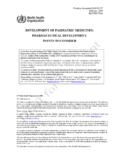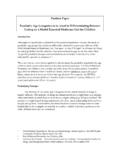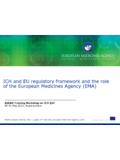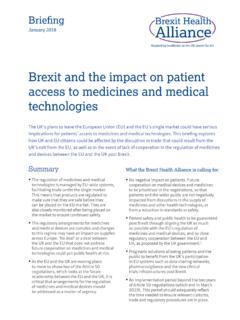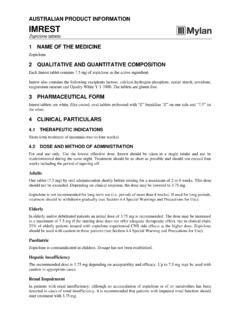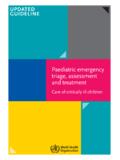Transcription of DEVELOPMENT OF PAEDIATRIC MEDICINES: POINTS TO …
1 Working document August 2011 RESTRICTED DEVELOPMENT OF PAEDIATRIC MEDICINES: POINTS TO consider IN pharmaceutical DEVELOPMENT REVISED DRAFT FOR COMMENT World Health Organization 2011 All rights reserved. This draft is intended for a restricted audience only, the individuals and organizations having received this draft. The draft may not be reviewed, abstracted, quoted, reproduced, transmitted, distributed, translated or adapted, in part or in whole, in any form or by any means outside these individuals and organizations (including the organizations' concerned staff and member organizations) without the permission of the World Health Organization.
2 The draft should not be displayed on any web site. Please send any request for permission to: Dr Sabine Kopp, Quality Assurance Programme, Quality Assurance & Safety: Medicines, Department of Medicines Policy and Standards, World Health Organization, CH-1211 Geneva 27, Switzerland. E-mail: with a copy to The designations employed and the presentation of the material in this draft do not imply the expression of any opinion whatsoever on the part of the World Health Organization concerning the legal status of any country, territory, city or area or of its authorities, or concerning the delimitation of its frontiers or boundaries. Dotted lines on maps represent approximate border lines for which there may not yet be full agreement. The mention of specific companies or of certain manufacturers products does not imply that they are endorsed or recommended by the World Health Organization in preference to others of a similar nature that are not mentioned.
3 Errors and omissions excepted, the names of proprietary products are distinguished by initial capital letters. All reasonable precautions have been taken by the World Health Organization to verify the information contained in this draft. However, the printed material is being distributed without warranty of any kind, either expressed or implied. The responsibility for the interpretation and use of the material lies with the reader. In no event shall the World Health Organization be liable for damages arising from its use. This draft does not necessarily represent the decisions or the stated policy of the World Health Organization. Should you have any comments on the attached revised proposal, please send these to Dr S. Kopp, Manager, Medicines Quality Assurance Programme, Quality Assurance and Safety: Medicines, World Health Organization, 1211 Geneva 27, Switzerland; fax: (+41 22) 791 4730 or e-mails: with a copy to Ms Marie Gaspard by 30 September 2011.
4 We will now send out our working documents electronically and they will also be placed on the Medicines web site for comment. If you do not already receive our draft specifications please let us have your e-mail address (to and we will add it to our electronic mailing list. Working document page 2 SCHEDULE FOR THE PROPOSED ADOPTION PROCESS OF DOCUMENT : DEVELOPMENT OF PAEDIATRIC MEDICINES: POINTS TO consider IN pharmaceutical DEVELOPMENT First draft POINTS for consideration prepared by Dr Susan Walters, Australia 14 May 2007 Further extended revision of the part on pharmaceutical DEVELOPMENT as a stand-alone text prepared by Professor Kristensen, Denmark February 2008 Circulation of document for comments as well as posting on Expert Committee and Prequalification web sites March-April 2008 Consolidation of comments and review in informal consultation May-June 2008 Circulation of revised draft for comments July 2008 Presentation to the forty-third WHO Expert Committee on Specifications for pharmaceutical Preparations 13-17 October 2008 Discussed at informal WHO meeting on Dosage Forms of Medicines for Children December 2008 Preparatory work involving coordination with other ongoing activities both within and outside WHO January 2009-March 2010 Discussed at informal consultation on pharmaceutical DEVELOPMENT of PAEDIATRIC medicines and pharmaceutical DEVELOPMENT for multisource (generic))
5 pharmaceutical products 29-30 April 2010 Continued coordination especially with EMA, UNICEF and the WHO Model List of Essential Medicines and the Essential Medicines project April-September 2010 Mailing of revision of draft document for comments October 2010 Presentation to the forty-fifth WHO Expert Committee on Specifications for pharmaceutical Preparations 18-22 October 2010 Annotated Rev. 2 sent by Professor Kristensen, Denmark February 2011 Annotated Rev. 2 discussed at informal consultation on pharmaceutical DEVELOPMENT of PAEDIATRIC medicines generics 4-6 May 2011 Revision 3 mailed for comments August 2011 Working document page 3 Consolidation of comments end-September 2011 Presentation to forty-sixth meeting of the WHO Expert Committee on Specifications for pharmaceutical Preparations 10-14 October 2011 Any further action as needed Working document page 4 BACKGROUND At the forty-second meeting of the WHO Expert Committee on Specifications for pharmaceutical Preparations held
6 On 15-19 October 2007, a draft on DEVELOPMENT of PAEDIATRIC Medicines: POINTS to consider (update of the version dated 14 May 2007) was discussed with a view to contributing to the pharmaceutical part of the document. This document was prepared by Professor Henning G. Kristensen, Denmark, and presented a first draft on pharmaceutical DEVELOPMENT of PAEDIATRIC medicines. It was based on the above-mentioned paper and the European Medicines Agency (EMA) Reflection Paper: Formulations of Choice for the PAEDIATRIC population (2006). An extended revision on pharmaceutical DEVELOPMENT as a stand-alone text was drafted in February 2008 (working document ). Upon circulation of this document a great number of comments were received. Valuable comments on the pharmaceutical DEVELOPMENT of PAEDIATRIC medicines were given, but they also showed that the draft gave too much emphasis on general issues of the DEVELOPMENT of generic medicines.
7 Work on a guideline on pharmaceutical DEVELOPMENT of multisource (generic) products was in progress with a first draft from June 2008. A WHO consultation on paediatrics and generics draft guidelines was held in April 2010, resulting in a revision of the generic guideline (working document ) circulated for comments in June 2010. An outline of the PAEDIATRIC guideline was discussed at the April 2010 consultation. Another version of the working document was prepared, based on the discussions during that meeting, the feedback and comments received on the previous version, and the report of the WHO Informal Meeting on Dosage Forms of Medicines for Children, December 2008. Upon wide recirculation, comments were received. This feedback was preliminary discussed during the Expert Committee on Specifications for pharmaceutical Preparations held in October 2010. A new revision was prepared by Professor Kristensen, taking new trends and DEVELOPMENT , such as the current efforts undertaken by regulatory authorities, into account.
8 The new proposal was then discussed during an informal consultation held on 4-6 May 2011. The outcome of that meeting is now again being widely distributed for comments. General note The POINTS to consider document should not detail instructions for the DEVELOPMENT but should rather make reference to relevant literature. Some of the matters dealt with in the draft on DEVELOPMENT of multisource products have, therefore, been omitted in this proposal. Working document page 5 Contents page 1. Introduction .. 2. PAEDIATRIC dosage forms.
9 Convenient, reliable administration .. Acceptability and palatability .. Minimum dosing frequency .. End-user needs .. 3. Dosage forms to be considered in particular .. 4. Formulation design .. Quality .. Biopharmaceutics classification Excipients .. Colouring agents .. Antimicrobial preservatives .. Sweetening agents .. Taste masking .. Solubility enhancers .. 5. Oral administration .. Oral liquid preparations .. Administration through nasogastric tubes .. Oral solid dosage forms .. 6. Rectal administration .. Suppositories .. Rectal liquids (enemas) .. 7. Parenteral administration .. 8. Dermal and transdermal administration .. Transdermal patches .. 9. Inhalations .. 10. Packaging and 11. Glossary.
10 12.. 1. INTRODUCTION Safe and effective pharmacotherapy in PAEDIATRIC patients requires the timely DEVELOPMENT of medicines and information on their proper use that suit the age, physiological condition and body sizes of the child. Formulations developed specifically for children are often needed. The use of unlicensed and off-label medicines in children is widespread. Their effects on children have not been properly studied, age appropriate formulations are generally not available, and they are not licensed for use in children. It is not the scope of this document to address extemporaneous preparations and compounding. A separate interim guidance document entitled " Provision by health-care specialists of patient-specific preparatiosn that are not available as authorized products POINTS to consider " (working document )" will supplement and deal with such preparations.










